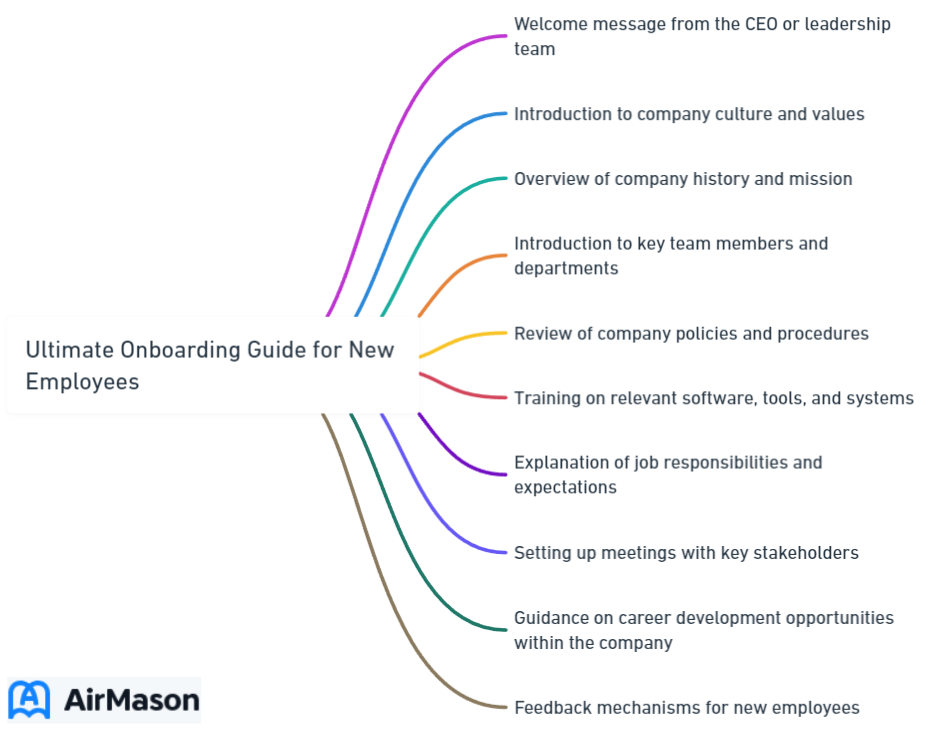
Starting a new job can be thrilling and daunting all at once. A well-structured onboarding guide is crucial to ensure a smooth transition into the company and lay the groundwork for long-term success. But, what exactly makes an onboarding process effective, and how can companies make it even better?
Key Takeaways
- Onboarding is an essential process for successful employee integration and retention.
- Utilize pre-boarding activities, orientation/training sessions, social integration, customized plans & feedback to create a positive onboarding experience.
- Leverage technology & best practices such as clear communication and ongoing support to ensure success.
Understanding the Onboarding Process
The new hire onboarding process is the method of integrating new employees into a company, focusing on orientation, training, and social aspects. Think of it as the bridge between the recruitment phase and the employee’s full immersion into their new role. It encompasses everything from:
- completing new hire paperwork
- familiarizing new hires with their job duties and responsibilities
- introducing new hires to the company culture and values
- providing training and resources to help new hires succeed in their roles
By implementing a comprehensive onboarding program, companies can ensure that new employees feel welcomed, supported, and prepared to contribute to the organization’s success.
A well-structured onboarding process plays a vital role in the success of any organization. Not only does it aid in attracting top candidates and reducing hiring costs, but it also helps decrease new hire turnover rates and increase employee engagement. The role of hiring managers is pivotal in facilitating a seamless onboarding experience for the new hire.

Definition and goals
The employee onboarding process is a series of steps that help new hires adjust to their work environment. It begins with accepting the job offer and continues until the end of their first year of employment. The primary aim of onboarding is to help new employees acclimate to their positions and the corporate atmosphere, ensuring a seamless integration and promoting sustained prosperity.
The onboarding process starts with the job offer and extends until the employee is fully acclimated in their role. It’s important that the job description matches the onboarding plan, preventing any miscommunication that could lead to dissatisfaction or potential departure from the company.
Importance for employee success
A well-implemented onboarding process can result in heightened employee satisfaction, increased efficiency, and enhanced retention rates. It forms new hires’ initial perception of the company, facilitates their productive involvement, and provides them with a clear roadmap for the initial 90 days and beyond at their new organization. The initial day of onboarding should establish a memorable, positive experience.
The initial 90 days provide a fundamental basis for the remainder of their tenure at the organization. Providing a comfortable environment for employees during onboarding contributes to increased employee satisfaction.
Employee Onboarding: Setting the Stage for Success
Employee onboarding is a critical process that lays the foundation for a successful professional journey within an organization. It encompasses the series of steps and activities aimed at integrating a new hire into the company culture, providing them with the necessary tools, resources, and information to excel in their role. Effective employee onboarding not only facilitates a seamless transition for the newcomer but also ensures they feel valued and supported from day one. This process typically includes orientation sessions, introductions to key team members, and an overview of company policies and procedures. Moreover, it offers an opportunity for the employee to become acquainted with the company’s mission, vision, and core values, aligning their goals with that of the organization. By investing time and effort into a well-structured onboarding program, businesses can significantly enhance employee retention, job satisfaction, and overall productivity.
Key Components of an Effective Onboarding Program

An effective onboarding program should encompass pre-boarding activities, comprehensive orientation and training sessions, as well as opportunities for social integration within the company. This ensures a well-rounded onboarding experience, addressing both the employee’s practical needs and their social well-being.
Pre-boarding activities
Prior to the arrival of new hires, it’s important to complete all necessary preparations including finalizing paperwork, conducting background checks, and enrolling them in benefits. This is a vital aspect of the onboarding process, as it sets the stage for the new employee’s experience and ensures that all necessary preparations are completed prior to their first day. To make this process smoother, a new hire onboarding checklist can be utilized.
Having a well-organized workspace, equipment, and resources ready for the new hire’s first day demonstrates that the company values their time and is prepared to support their success. This early attention to detail can contribute to a positive onboarding experience and help new hires feel welcomed and appreciated.
Orientation and training
Orientation and training sessions are designed to provide new employees with comprehensive information about the company, their role, and any relevant skills or tools necessary for success. These sessions may include on the job training, as well as:
- Presentations on company policies
- Safety procedures
- Other pertinent information
- Hands-on training for specific job tasks
During orientation and training, introducing new hires to their managers and team members is beneficial as it helps them comprehend their position within the organization. These sessions, which are indispensable for a successful onboarding experience, require sufficient time allocation.
Social integration
Social integration in onboarding is designed to help new hires create meaningful connections with their colleagues and foster a sense of belonging within the company culture. This can be achieved through various activities, such as team lunches, group activities, and one-on-one conversations, which all contribute to developing relationships and creating mentorship opportunities.
A strong sense of social integration can have a lasting impact on employee performance, job satisfaction, and overall well-being. By fostering a culture of inclusion and belonging, companies can ensure that new hires feel supported and valued, which in turn boosts employee retention and contributes to a successful onboarding experience.
Creating a Customized Onboarding Plan

Customizing the onboarding plan for each new employee ensures that their unique needs are met, expectations are aligned, and progress is monitored effectively. This personalized approach can result in a more efficient onboarding process and higher levels of satisfaction and engagement from new hires.
Assessing individual needs
In order to customize the onboarding process, understanding each new hire’s individual needs is fundamental. This understanding can be gained through methods such as personal interviews, surveys, and questionnaires that provide insights into the new hires’ backgrounds, preferences, and goals. By understanding what each new employee requires to succeed, companies can create a customized onboarding plan that addresses their specific needs and ensures a smooth transition into their new role.
A customized onboarding plan allows companies to:
- Allocate resources and support where they are most needed
- Help new hires feel valued and understood
- Lead to higher employee satisfaction
- Improve performance
- Increase retention rates
Setting realistic expectations
For a successful onboarding experience, it’s important to set realistic expectations for new employees. This involves clearly outlining the roles’ goals and objectives, along with the performance expectations during the initial months on the job.
By setting clear expectations, both the new hire and the new hire’s manager can better understand and align their efforts towards achieving the company’s goals. Additionally, this helps to create a sense of accountability and commitment from the new employee, leading to increased job satisfaction and long-term success.
Monitoring progress and providing feedback
It’s necessary to routinely monitor progress and offer constructive feedback to facilitate growth and success for new hires in their roles. Implementing SMART (Specific, Measurable, Achievable, Relevant, Time-bound) goals can be an effective way of tracking progress and ensuring that goals align with the overall objectives of the onboarding process and the employee’s role within the organization.
Providing regular feedback allows new hires to identify areas for improvement and adjust their efforts accordingly. This ongoing support and guidance can foster a culture of continuous learning and development, ultimately leading to higher levels of employee satisfaction, engagement, and retention.
Onboarding Document
An onboarding document is a crucial tool for seamlessly integrating new employees into an organization. This comprehensive guide encompasses all the essential information and resources a new hire needs to navigate their initial days and weeks within the company. The onboarding document typically includes vital details such as the company’s mission and values, organizational structure, and an overview of the team they’ll be working with. Additionally, it outlines important policies, procedures, and compliance requirements, ensuring that the new employee is aware of the expectations and standards set by the organization. Furthermore, the document often features information about company benefits, HR contacts, and other practical details, streamlining the acclimatization process for the newcomer. A well-crafted onboarding document not only facilitates a smooth transition for the new employee but also sets a positive tone for their journey within the organization. It serves as a valuable resource that empowers employees to hit the ground running, contributing to their productivity and overall satisfaction.
Leveraging Technology for Efficient Onboarding

The use of technology can enhance the onboarding process, creating a more efficient and enjoyable experience for both new hires and HR teams. From automating tasks to improving communication and ensuring a consistent experience, technology can play a vital role in optimizing the onboarding experience.
Benefits of onboarding software
Onboarding software has the potential to automate tasks, enhance communication, and guarantee a uniform experience for all new hires. These tools can enhance the onboarding experience by optimizing communication channels, promoting organizational culture, and enabling feedback collection through surveys and messaging platforms. An onboarding checklist can ensure that all essential steps are followed for a smooth transition.
Moreover, onboarding software can save HR teams time and resources by streamlining the onboarding process, allowing them to prioritize building relationships with new hires. By leveraging technology, companies can create a more efficient and enjoyable onboarding experience for everyone involved.
Popular onboarding tools
Popular onboarding tools include Asana, RoboRecruiter, TalentLyft, Lever, and Datapeople, each offering unique features to enhance the onboarding process. Asana, for example, provides a range of features for work, project, and task management, communication tools, and numerous integrations with other apps, making it an ideal onboarding tool.
RoboRecruiter leverages SMS and chatbots to streamline the recruitment process, while TalentLyft offers a comprehensive onboarding process designed to enhance job satisfaction and bolster retention rates. Leveraging these popular tools can significantly improve the onboarding experience for new hires and make the process more efficient for HR teams.
Best Practices for a Successful Onboarding Experience

Implementing best practices for onboarding, such as clear communication, inclusion of company culture and values, and ongoing support and development, ensures a successful experience for new employees, leading to higher satisfaction and retention rates.
Clear communication
Clear and regular communication throughout the onboarding process is key to ensuring a positive experience. Starting with the offer letter and continuing through the first year, regular communication helps new hires understand their roles, responsibilities, and expectations, while also fostering a sense of camaraderie and teamwork.
By establishing a consistent communication channel, companies can provide direction, build trust, and address any issues or concerns that may arise. This open line of communication can significantly contribute to a positive onboarding experience, ultimately leading to higher employee satisfaction and retention rates.
Inclusion of company culture and values
Integrating the company’s culture and values into the onboarding process is key to fostering a sense of connection and engagement for new hires with the organization. By introducing new employees to the company’s mission, vision, and values, companies can help foster a sense of belonging and alignment with the organization’s overall objectives.
Activities such as team lunches, group activities, and one-on-one conversations can provide opportunities for new hires to connect with their colleagues and immerse themselves in the company culture. This sense of connection and engagement can lead to higher employee satisfaction, improved performance, and increased retention rates.
Ongoing support and development
Offering continuous support and opportunities for development is crucial to the long-term success of new employees within the company. This can include offering continuous professional development, creating individualized development plans, and providing regular constructive feedback.
By offering ongoing support, companies can cultivate a culture of continuous learning and development, ultimately leading to higher levels of employee satisfaction, engagement, and retention. Ensuring that new hires have the resources and support they need to grow and succeed in their roles is essential for fostering a positive and productive work environment.
What Are the 4 Phases of Onboarding
The 4 phases of onboarding encompass crucial steps in integrating a new employee into an organization seamlessly. The initial phase involves orientation, where the new hire becomes acquainted with the company’s mission, values, and culture. This is a vital step as it sets the foundation for the employee’s understanding of their role within the organization. Following orientation, the second phase focuses on training. During this phase, employees receive job-specific training, covering tasks, responsibilities, and any necessary technical skills. It’s essential to provide comprehensive training to ensure the employee feels confident and capable in their new role.
Summary
In conclusion, an effective onboarding process is vital for the success of both new hires and the organization as a whole. By implementing best practices, customizing the onboarding experience, leveraging technology, and providing ongoing support and development, companies can create a positive and engaging onboarding experience, leading to higher employee satisfaction, increased productivity, and improved retention rates. Investing in a well-structured onboarding process is truly an investment in the future success of the company and its employees.
Frequently Asked Questions
What are the 4 C’s of effective onboarding?
The 4 C’s of effective onboarding involve Compliance, Clarification, Connection and Culture to ensure successful employee integration into an organization. This framework was developed a decade ago based on the academic research published by the SHRM Foundation.
What should be in an onboarding guide?
An onboarding guide should include a friendly note from the new hire’s manager, first-day information, welcome messages and photos from new teammates, a glossary of company acronyms, a virtual copy of the employee handbook, and details about the new hire’s department and job.
What is the 4 step onboarding process?
The onboarding process consists of four steps: pre-boarding, orientation, training and integration, all customisable with eloomi’s checklists, templates and training programs for a smooth transition.
How can technology improve the onboarding process?
Technology can help improve the onboarding process by automating tasks, improving communication and providing a consistent experience for all new employees.
What role does clear communication play in the onboarding process?
Clear communication is essential for successful onboarding, allowing new hires to understand their roles, responsibilities and expectations and promoting a sense of camaraderie.